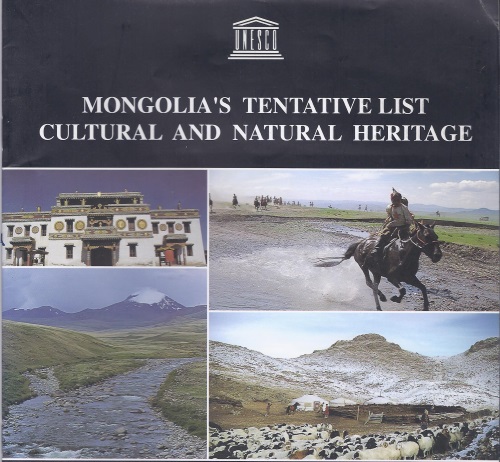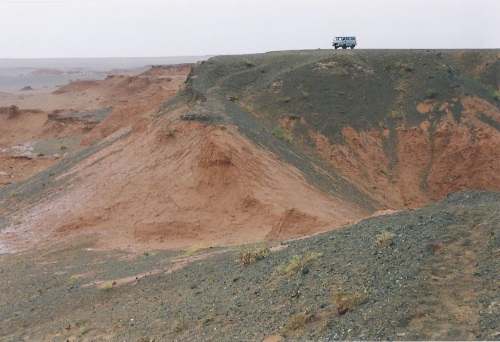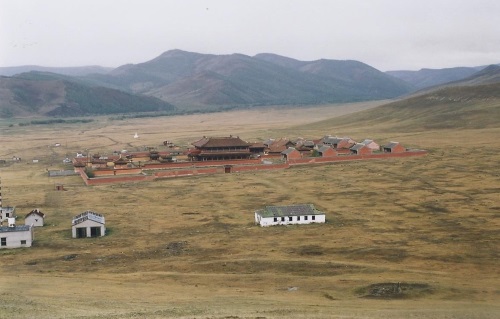Blog Countries
Mongolia's Tentative List
In December 2014 Mongolia submitted a new Tentative List. It holds 13 sites, of which several such as the Gobi desert, the Desert fossil sites, Amarbayasgalant Monastery and a group of Sacred Mountains have appeared under different aliases on earlier lists. This renewal might be the start of intensified Mongolian WH activity during the coming years. Now awarded with only 3 WHS, this vast and unique country certainly has potential for more.
 |
| Cover of a booklet that I bought in Mongolia in 2002, before it had any WHS |
I could not find a schedule of the proposed nominations, but what we do know is that Mongolia is up for 2 new WHS in 2015! First there's the natural site "Landscapes of Dauria", a transboundary nomination with Russia. This steppe is already a UNESCO World Biosphere Reserve and Ramsar Site. It's the breeding ground for the white-naped cranes, ranked as "vulnerable" by IUCN. Unless local authorities start to dig for oil, build a pipeline or a dam in this area I see no reason why it would be rejected.
The other one is "Great Burkhan Khaldun Mountain and its surrounding sacred landscape". Strangely this isn't on the T List anymore, it was incorporated in the much broader Sacred Mountains of Mongolia. The site suffered from incomplete documentation for 2014 (as did Dauria by the way). And already in 2010 an incomplete dossier on Mongolian Sacred Mountains had appeared in the records, so they're tossing around a bit with this. The nomination file that I have in my possession is titled "Great Burkhan Khaldun", but to make things even more complex it includes two other sacred sites that have their own T list entries: Sacred Binder mountain and Baldan Bereeven monastery, all "outstanding representatives of Mongolia's nomadic culture". However, there's no link to other sacred mountains in this nomination, and neither Binder and Baldan Bereeven are part of the Sacred Mountains TWHS. So which site is Mongolia nominating exactly?
 |
| Our vehicle in Bayanzag |
Among the other 11, there's a dazzling array of "sacred mountains", "nomadic landscapes" and "steppes". The Gobi Desert (Desert Landscapes of the Mongolian Great Gobi, which covers an area larger than Switzerland) should be a shoo-in, but maybe is too large to propose right first time. One of the more interesting sounding other ones is the "Cretaceous Dinosaur Fossil Sites in the Mongolian Gobi". This is a serial site with dinosaur fossils, tracks and footprints. In 1922 a dinosaur egg nest was discovered here, "the first solid evidence that dinosaurs laid eggs". While the "simple" dinosaur track site Cal Orck'o (Bolivia) will try to get inscribed again in 2016, these Gobi Fossil Sites look so much more promising.
In 2002 I visited the "Flaming Cliffs" of Bayanzag, one of its 13 components. We saw the flat Mongolian landscape suddenly change into something resembling the Grand Canyon. There used to be a large lake here, and that's where many dinosaur remains have been found. We (4 tourists) spent some time looking for them too. There are lots of bones visible, but to the untrained eye the bones of a dead camel are difficult to distinguish from those of dino's. An area well worth visiting nevertheless.
 |
| Amarbayasgalant Monastery |
Finally, Amarbayasgalant holds special meaning to me as it was the first sight outside Ulaan Bator that I visited on my trip to Mongolia in 2002. I can clearly remember the long drive out there, and especially an enormous bird we encountered by the side of the road (I have an irrational fear of birds!). Amarbayasgalant is a remote, 18th century monastery built to honour the first Buddhist leader of Mongolia. It holds a great collection of thangkas.
Els - 28 February 2015